
Turn Up Your Speakers
These Pages High in Graphics
Please be patient as they load.
Flag Day

History of the Flag, the History of Flag Day
Though the Flag was first
celebrated in 1877, with the centennial of the U.S. flag's existence, the
idea of making it a public celebration is believed to have originated in
1885.
In course of time a number of individuals and organizations advocated the
adoption of a national day of commemoration for the U.S. Flag. However, B.J.
Cigrand, a teacher from the Wisconsin Public School, District 6, is
believed to be a forerunner of the thought.
He organized the pupils in the Fredonia, to observe June 14 as 'Flag
Birthday'. It was the 108th anniversary of the official adoption of The Stars and
Stripes, the first national flag of the United States.
It was a bid to inspire and educate the school children with spirit of the
Flag as well as love for the nation. And it was not a single shot
bid. Cigrand continued to advocate the need for its observance in the
following years through numerous magazines and newspaper articles and
public addresses. But the celebration was yet to take off in a well defined
style and in a wider scale.
On June 14, 1889, George Balch, a kindergarten teacher in New York City, planned
appropriate ceremonies for the children of his school, and his idea of
observing Flag Day was later adopted by the State Board of Education of New
York. On June 14, 1891, the Betsy Ross House in Philadelphia held a
Flag Day celebration, and on June 14 of the following year, the New York
Society of the Sons of the Revolution, celebrated Flag Day.
Inspired by Colonel J Granville Leach, a historian, the Pennsylvania
Society of Colonial Dames of America adopted a resolution on April
25, 1893. The resolution requested the mayor of Philadelphia and all
others in authority and all private citizens to display the Flag on June
14th. Leach went on to recommend that thereafter the day be known as
'Flag Day'. It was also recommended that on that day, school children
be assembled for appropriate exercises, with each child being given a small
Flag.
As a result of the resolution, Dr. Edward Brooks, then Superintendent of
Public Schools of Philadelphia, directed that Flag Day exercises be held on
June 14, 1893 in Independence Square. School children were assembled, each
carrying a small Flag, and patriotic songs were sung and addresses
delivered.
In 1894, the governor of New York directed that on June 14 the Flag be
displayed on all public buildings. Meanwhile, with BJ Cigrand and Leroy Van
Horn as the driving force, the Illinois organization, known as the American Flag Day Association, came
into being. Its purpose was to promote the holding of Flag Day exercises.
And thanks to its initiative, on June 14th, 1894, the first general public
school children's celebration of Flag Day in Chicago was held. More than
300,000 children participated in the programs held various parks across Chicago.
Adults, too, participated in patriotic programs in different parts of the
country. And the celebration registered increasing popularity as more and more
localities and states over the next three decades.
The Proclamation of President Woodrow Wilson established it officially on
May 30th, 1916. While Flag Day was celebrated in various communities for
years following Wilson's proclamation, it was not until August 3rd, 1949, the
14th of June was designated by President Harry Truman as National Flag Day
to be celebrated each year across the nation.
|
The
American national flag has come through a course of changes. It was
changed some 27 times from 1777 to 1960. |
The Stars and Stripes came to
be regarded as the national flag with the official recognition of the
Continental Congress on June 14, 1777. This was the year following our nation's
Independence. What was there before this Stars and Stripes came to secure
its berth as the national flag? Which one was used to really flag off the
journey of an independent Union of American States. What did it look
like?
The Grand Union Flag:
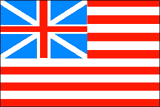 |
It showed the British Union
Flag of 1606, the predecessor of the Union Jack, in the canton. Its
field consisted of seven red and six white alternated stripes
representing the 13 colonies. The latter officially replaced it on June
14, 1777. |
Other earlier versions:
| There were some other early versions of the Flag. A very popular one among them was, the first Navy Jack. It had the 13 red-white stripes with a rattlesnake overall, and the motto "Don't Tread on Me." |  |
The 1st national Flag:
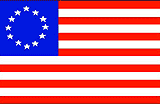 |
Called the Stars and Stripes, this was formally approved by the Continental Congress--on June 14, 1777. The blue canton was to contain 13 stars, but the layout of the stars was left undefined, and several patterns are known. The one designed by the legendary Betsy Ross is said to feature the stars arranged in five rows of either two or three stars. |
The Navy adopted its own flag
| Some related designs that followed soon, include the 76 Flag. It was flown at the Battle of Bennington on Aug. 16, 1777. | 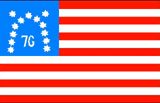 |
Hulbert's Stars and Stripes
 |
Yet another contemporary flag that was cast in the mold of the Stars and Stripes was the one designed by John Hulbert, a magistrate. Its stripes were the same but the canton featured a diamond-shaped field of 13 stars. |
The Stars and Stripes - 1795 version
| Stars and Stripes remained unchanged until May 1, 1795, when two more stars and two more stripes were added to reflect the admission to the union of Vermont (1791) and Kentucky (1792). It was this flag that inspired Francis Scott Key to write the "Star Spangled Banner". | 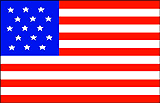 |
Stars & Stripes - 1818 version
 |
In 1818, with five more states being admitted, the Congress enacted legislation. This stated that henceforth the stripes should remain 13, whereas the number of stars should always match the number of states. It was also decided that any new star should be added on the July 4 following a state's admission. This has been the system ever since. |
The 1863 version:
| On May 1, 1863, a new national flag, the Stainless Banner was adopted. However, the design did not last long. | 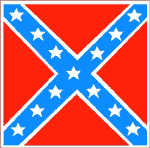 |
The 1865 version:
 |
But a still short lived was a
modification of the Stainless Banner. It was adopted, rather futilely,
about a month before the end of the war in April 1865. |
Stars and Stripes - standardized version
| Since then every time a new state was annexed, the size of the canton, as well as the stripes got altered, so as to accommodate the increased number of stars. It took to Oct. 29, 1912, when an executive order standardized the proportions and relative sizes of the elements of the flag. |  |
However, the exact shades of color
of the elements were yet to be standardized.
And it took till 1934 to standardize this.
The national flag which we see these days has been effective since July 4, 1960.
This was following the inclusion of Hawaii in the United States of America.
However, this flag featuring 50 stars on a canton against the background of 13
stripes
- 7 red and 6 white - has been evolved through a long period of eventful years.
|
|

|
I pledge allegiance to the
flag of the United States of America and the Republic for which it
stands, |
Stand upright, remove headdress, if any, and place the right
hand over the heart while reciting the pledge.
Now, a few words about the origin of the pledge:
The pledge was first brought out in the juvenile periodical The Youth's
Companion on Sept. 8, 1892, in the following form:
"I pledge allegiance to my
Flag and the Republic for which it stands;
one nation indivisible, with liberty and Justice for all."
"I pledge allegiance to the
flag of the United States of America
and to the Republic for which it stands, one nation under God,
indivisible, with liberty and justice for all."
The Colors of the Flag
Red, White &
Blue
There is no official assignment of
meaning or symbolism to the colors of the flag.
However, Charles Thomson, secretary of the Continental Congress, in describing
the Great Seal, related its colors to those of the flag.
According to Thomson,
"White signifies purity and innocence,
Red, hardiness & valor,
and Blue . . . vigilance, perseverance & justice."
|
vigilance, perseverance & justice |
|
purity and innocence |
|
hardiness & valor |
So the Red and White stripes of 13
represent the link
to the original ground of 13 states on which the nation has been built up.
And the stars, representing the union of now 50 states,
have been laid on the blue canton to bind all of them
with the bond of vigilance, perseverance and justice.
The Stars & Stripes
The National Anthem
| The Stars and Stripes that adorns the crown of the United States of America for over 240 years. Over the ages it has been an undaunted source of inspiration for all of us. It gave us a unique identity and a sense of belongingness with this glorious land. It kept us feel proud of our nation's achievement, and also led us to champion its causes. It inspired the happenings of quite a lot of events - recognized as milestones in the history of development of the nation. |
And this traditional role of the Stars and Stripes is well
written in the way our national anthem was born. This is how:
Though according to the Paris peace treaty in 1783 there was cessation of arms
and Britain was compelled to give recognition to the union of 13 colonies,
Britain was not yet ready to give up its share of pie from the resourceful New
World. On the other hand, Americans who started to operate as a union of 13
states, soon looked for expansion of their territories. The clash of interests,
muffled up for a while by the peace treaty, cast their harrowing shadows
over the peace process. Finally, in 1812 the second war between the British, and
the Americans who were then committed to expand their territories, broke out.
The U.S. entered the war ill-prepared. And the ambitious plans to invade Canada
were never realized. American warships won three notable victories in duels with
British frigates in 1812, But this did not end the war. In fact, it just kept
going.
Guarding the entrance to Baltimore harbor via the Patapsco River during the War
of 1812, Fort McHenry faced almost certain attack by British forces. Major
George Armistead, the stronghold's commander, was ready to defend the fort, but
he wanted a flag that would identify his position, and one whose size would be
visible to the enemy from a distance. Determined to supply such a flag, a
committee of high-ranking officers called on Mary Young Pickersgill. She was a
Baltimore widow who had had experience making ship flags, and explained that
they wanted a United States flag that measured 30 feet by 42 feet. And, she
agreed to the job.
With the help of her 13-year-old daughter, Caroline, Mrs. Pickersgill spent
several weeks measuring, cutting, and sewing the 15 stars and stripes. When the
time came to sew the elements of the flag together, they realized that their
house was not large enough. Mrs. Pickersgill thus asked the owner of nearby
Claggett's brewery for permission to assemble the flag on the building's floor
during evening hours. He agreed, and the women worked by candlelight to finish
it. Once completed, the flag was delivered to the committee, and Mrs.
Pickersgill was paid $405.90.
In August 1813, it was presented to Major Armistead. But, as things turned out,
more than a year would pass before hostile forces threatened Baltimore. The
British headed for Baltimore. On the morning of September 13, 1814, British bomb
ships began hurling high-trajectory shells toward Fort McHenry from positions
beyond the reach of the fort's guns. The bombardment continued throughout the
rainy night.
In September 1814, the US lawyer Francis Scott Key was sent to the British fleet
in Chesapeake Bay to secure the release of his friend William Beanes, who had
been captured after the defeat of the U.S. forces at Bladensburg, Md. He was
detained aboard ship during the shelling of Ft. McHenry, one of the forts that
successfully defended Baltimore. During the night of the bombardment, September
13-14, Key's anxiety was at high pitch, and in the morning when he saw the
American flag still flying over the fortress, he wrote "The Star-Spangled
Banner." Released that day, he rewrote the poem in a Baltimore hotel. It
was printed anonymously under the title "Defense of Fort M'Henry" and
on September 20 was published by the Baltimore Patriot. Set to the tune of an
English drinking song, "To Anacreon in Heaven," it soon became popular
throughout the nation. It was later adopted by the army and navy as the national
anthem, and in 1931 it was officially adopted by Congress.
Respect
and Care of the Flag ~ Flag Code of the United States
Music & Books Offered in Association with Amazon
For
More Patriotic Titles Click Here
Information / Sources:
White House.gov
The Holiday Spot
US Flag.Org
Copyright ©Emotions Greeting Cards a division of VH Productions 2000-2002